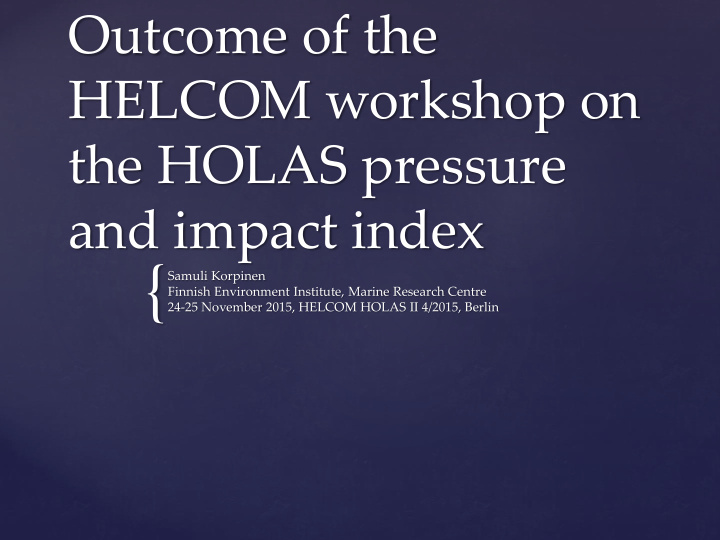



Outcome of the HELCOM workshop on the HOLAS pressure and impact index { Samuli Korpinen Finnish Environment Institute, Marine Research Centre 24-25 November 2015, HELCOM HOLAS II 4/2015, Berlin
Main objectives Define data sets for pressures and ecosystem components Consider development of impact conversion factors Advice on further development of the method
Spatial datasets Prioritization of the activity data CULTIVATION OF MARINE RESOURCES (1): Finfish mariculture PRODUCTION OF ENERGY (3): Wind farms, Nuclear energy production, Cables EXTRACTION OF LIVING RESOURCES (7): Demersal long lining, Pelagic long lining, Benthic trawling, Pelagic trawling, Leisure fishing, Fishery with coastal stationary gear, Game hunting EXTRACTION OF NON-LIVING RESOURCES (12): Extraction of sand and gravel, Oil and gas industry infrastructure, Pipeline placement and operation, Land claim, Canalisation, Culverting/trenching, Dams, weirs, Seawalls, Breakwaters, Groynes, Flood protection, fairway dredging URBAN AND INDUSTRIAL USE (4): Deposit of dredged material, Coastal waste water treatment plants, Military infrastructure, Waste disposal (munitions) TOURISM AND LEISURE (2): Marinas and leisure harbours, Bathing sites, beaches, TRANSPORT (3): Industrial and ferry ports, Bridges and causeways, Passage of ships/boats
Spatial datasets Prioritization of pressure data PHYSICAL (3): physical loss, disturbance to seabed, extraction of seabed substrate HYDROLOGICAL (1): Changes to hydrological conditions ENERGY (3): Input of ambient noise, input of impulsive noise, input of electromagnetism SUBSTANCES (31): haz.substances, deposit of dredged material, dumped chemical munitions, litter, nutrients, organic matter BIOLOGICAL (3): offshore commercial catches, coastal catches, non-indigeneous species
Spatial datasets Prioritization of ecosystem data EMODnet Seabed habitats Water-column habitats Natura 2000 habitats BSAP habitat-forming species Functional habitats Mammal distributions
Recent development A review of existing spatial methods to assess cumulative pressures and impacts (EEA/ETC 2015) Since HOLAS I: a spatial assessment in all the 4 EU marine regions + smaller assessments OSPAR BH3 common indicator FP7 BENTHIS: fishery impacts on sea floor HARMONY Pressure and Impact Mapper Software SYMBIOSE pressure metadata fact sheets FP7 ODEMM: Linkage framework
Setting the impact weights Traditional approach Proposed HOLAS II approach Expert given estimates Ambition level higher: based on: - use of scientific literature - how widely an impact and the LiaCAT tool affects the ecosystem?, - aim to have stronger impact - how strong the impact weights for the main is?, pressures - how long it takes to - support from expert recover from the judgment when literature- pressure? based evidence is weak (or - confidence of the not exist). estimate.
How to include uncertainty WS recommended to have separate confidence maps. The impact weight scores have inherent uncertainty, which will be included in the score. The data layers can also be weighted according to the quality of the layers level of certainty based on pre- identified criteria. Worst case and best case scenarios could be assessed based on the variation/ranges in impact scores
Where are we now? Where do we need to go? Data layers have been identified start collecting the data. Make metadata fact sheets for each data layer useful product as it is. We have a software to make the index (and different outputs) this is a ’ push-the-button work ’. The LiaCAT tool will be a useful database for impact estimates much work to include all impact studies and standardize the impacts. An online survey of impacts exists and will be used in TAPAS will support the LiaCAT; needs to be run later?
Recommend
More recommend